Garden Glimpses: May Day
As April wanes and fades into the lusty month of May, spring bulbs in the garden are waning, too, but there’s a last flourish of late-season daffodils to enjoy, and the muscari are at their peak. Perennials have returned, and are lush with new green growth (or in the case of heucheras, that might be rose, bronze, burgundy, yellow or purple growth!), and some have even bloomed.
This year the garden development project was to install spring ephemerals, things such as hellebores (Lenten rose), mertensia (Virginia bluebells) and geranium, which bud and bloom early, then fade into the background. These are still awaiting delivery and planting, but perhaps we’ll yet see some of their flowers this first season, albeit delayed. In the shade of the paper birch and maple, I wanted to create something like the woodland spaces I knew and loved as a child, when I would accompany my father on fishing expeditions to local creeks and ponds, and with his help identify the flora bursting into bloom all about us.
So I have also ordered Arisaema Triphyllum (the lime-and-purple-streaked Jack-in-the-pulpit), Erythronium Americanum (vivid yellow dogtooth violet, flecked with brown), Trillium Recurvatum (a bronzy-red variety of the more familiar white-flowering forest floor staple) and Podophyllum Peltatum (the elegant umbrella-shaped May apple). I hope in time these will fill the space to create a mid-spring wonderland that adds interest as the earliest bulbs recede, and before the summer perennials hold sway.
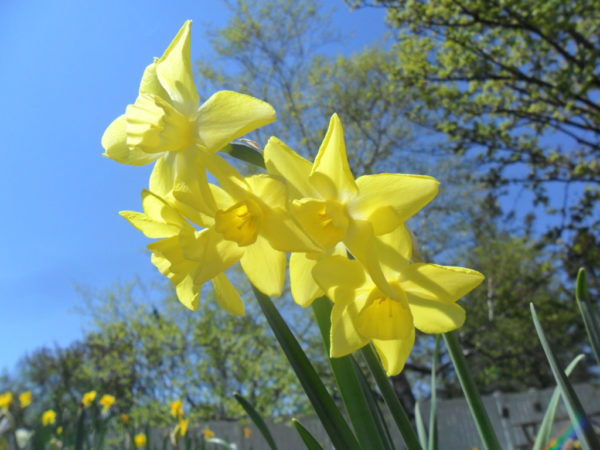
But for now, narcissus is still king!
Mid-late season brings a variety of multi-blossom daffodils, with 2, 3, 4 or as many as 8 blooms per stem. “Pipit” is in its second year on the property, with smaller, pleasant sunny yellow pairs or triplets of flowers that mature to whitish cups and inner margins at the base of the petals surrounding the cup.

“Bantam” is a newcomer, and as feisty as its poultry namesake – with five to eight diminutive blossoms per stem, clustered in an almost globelike pattern, it sports vivid yellow petals with short, flared bright orange cups.

“Blushing Lady” was a pleasant surprise, with a color scheme very reminiscent of “Tom Pouce”, next to which it is planted, but with two or three much smaller blooms per stem. Billed as soft yellow petals with a pink cup, the color is more peachy-bronze to my eye, but lovely in combination with its more robust, single-flowered cousin.
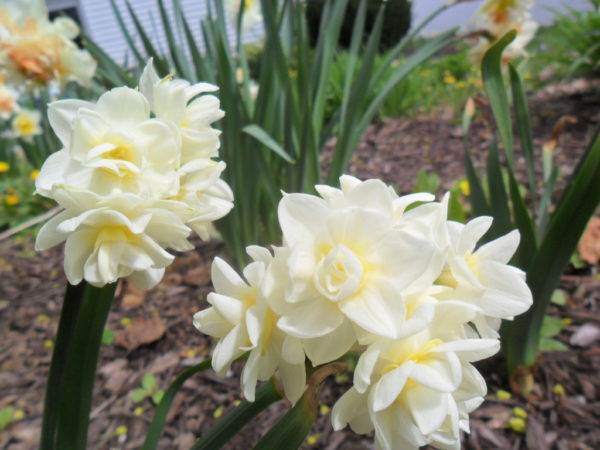
“Spring Cheer” is a cream-colored beauty, with globular clusters of 5 or 6 fluffy doubled mini-blossoms that glimmer with yellow at the petal base, forming an almost perfect circle of bloom at the end of each stem. This second-year daffodil didn’t expand noticeably from its first year showing, but is holding its own.
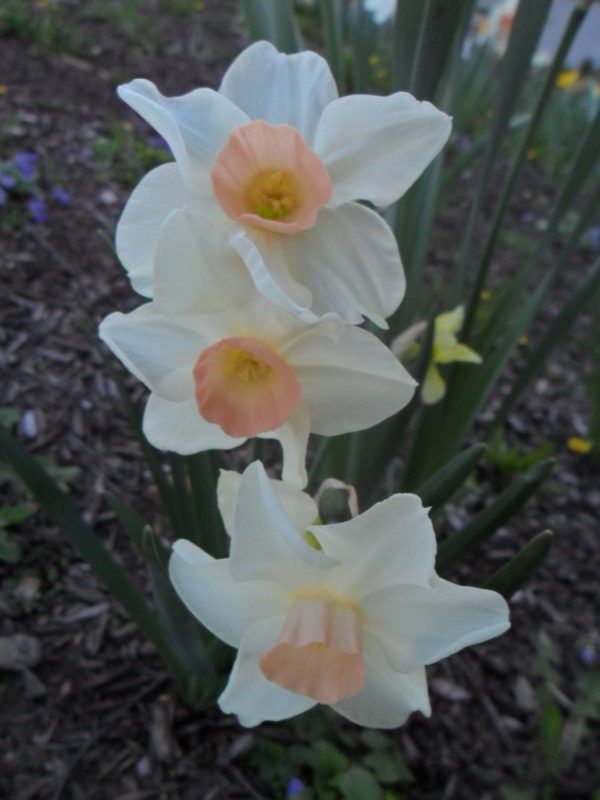
“Bell Song” is another second-year veteran, and though one small clump came up without any blooms at all, most have added 2 or 3 stems per bulb, a pretty good return on investment. The flowers come two to a stem, are on the smaller side, but extremely beautiful, with off-white petals that are slightly frilled at the edges, and delicate cups that emerge dawn pinkish-yellow and mature to pastel coral.
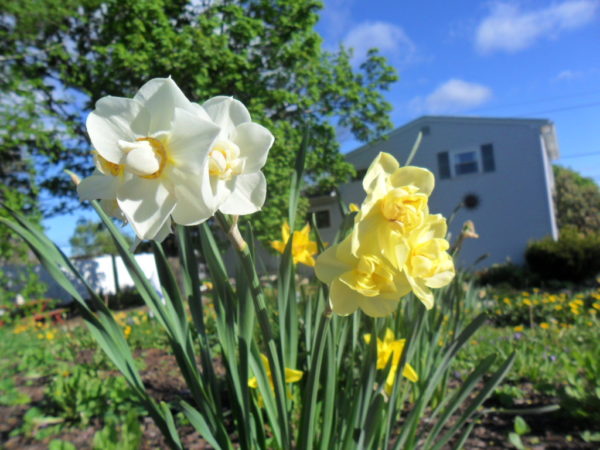
There are several other multi-headed daffodils, some of which came as heirlooms, others in unmarked collections for naturalizing, which I cannot identify. The heirloom has flowers similar to “Spring Cheer”, but distributed on short terminal branches that separate the individual blossoms at the end of the stem. One of the newbies is much the same, but in pastel yellow, and another has sparkling yellow centers surrounded by creamy petals. Each has 3 to 4 blooms per stem.
My continuing quest for a truly pink daffodil seems to be getting closer to its finish. I wouldn’t say I’m quite there yet, but some of these late season narcissus come darn close!
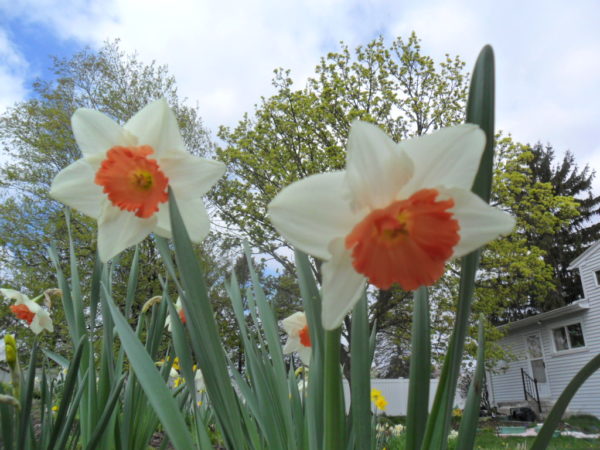
“Pink Charm” is probably closest to my ideal. A second-year vet, this late bloomer has vivid coral-pink cups surrounded by bright white petals, and is medium-sized. A larger cousin is newcomer “Accent”, with foot-long plus stems, large medium pink cups and creamy white petals.

As ever, my favorite yellow/orange combination was not forgotten for late season daffodils. “Falconet” is amongst the latest to bloom, and midrange in blossom size, with flowers about midway between diminutive Bantam and full-bodied Brackenhurst, but sporting the same color palette. Falconet’s cups, however, are bicolored, and have a deep yellow base with vivid orange flares at the terminus, backed by bright yellow petals.
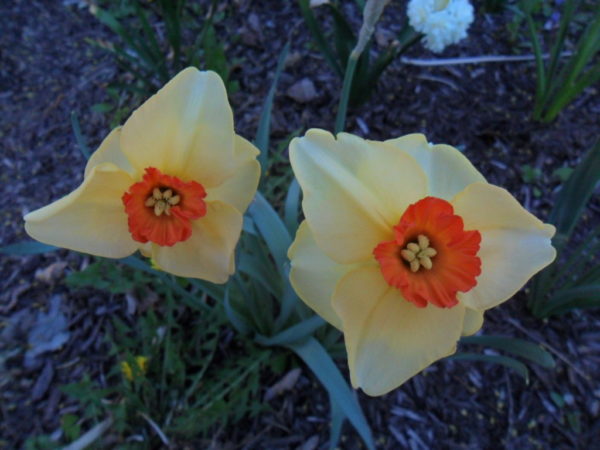
Also in this class is “Altruist”, with almost caramel petals studded by dark orange foreshortened cups. This is Altruist’s sophomore year, and shows a respectable increase in size.
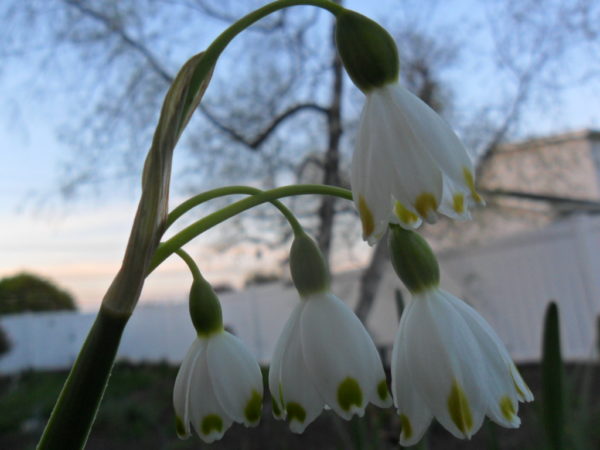
Among the latest to bloom is “Leucojum Aestivum”, the narcissus that isn’t! Commonly known as “Summer Snowflakes”, Leucojum is in a class by itself; native to much of Europe from Ireland to the Ukraine, its foliage is daffodil-like, virtually indistinguishable from narcissus, but its flowers are more akin to fritillaria, even wood hyacinth. Bell-shaped and pendulous, these off-white beauties are dotted with green on each petal, and come three to five to a stem. When I grew them in Philadelphia, I called them “Beltane Bells” due to their uncanny ability to be in full flower for that holiday.
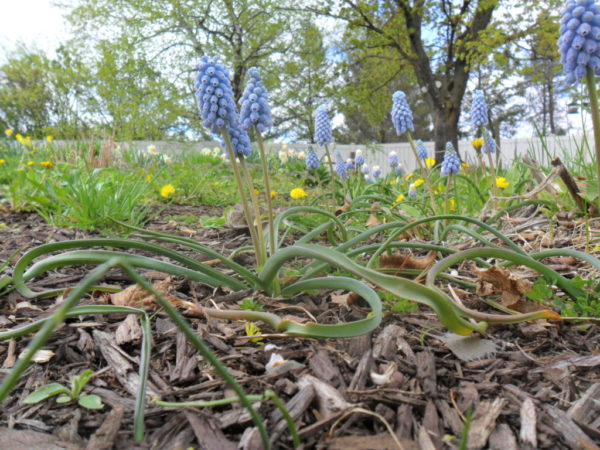
Late April is also the heyday of muscari, or grape hyacinth. Most commonly seen in gardens as the ubiquitous bluebell, muscari come in a wide range of colors, and I have been supplementing my heirloom bluebells with several of the newer varieties. In 2019 we planted a pale baby-blue variety, “Valerie Finnis”, characterized by much longer bloom-heads than typical. Now in their second year, these are putting on quite a show, lining the paths from the gate, and up to the top of the sand mound.
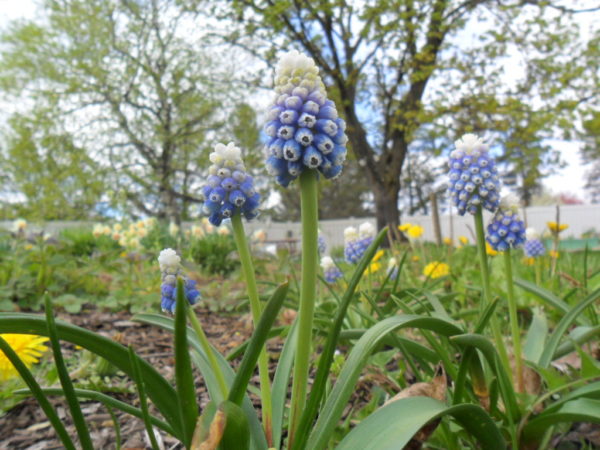
Even more surprising is “Sky Blue” a misnamed (to my mind) variety which is actually tricolor! With azure blue at the base, baby blue amidships, and a white crown, this is one of the most impressive muscari I have seen, a combination show-stopper and conversation-starter.

Last autumn I acquired three more varieties – “Pink Sunrise”, “Siberian Tiger” and “Golden Fragrance.” Pink Sunrise bloomed earliest, and is well past by the time her sisters come into flower (sometimes first-year bulbs will bloom out-of-season, early or late, and I’m hoping these will regularize over time and bloom jointly with the others, though it’s also nice to see this early color). Palest pink, they mature to rosy cream.
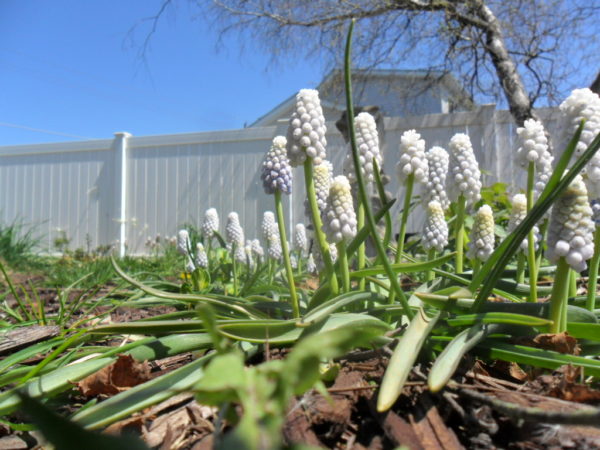
Siberian Tiger has outperformed my expectations, with full clumps of white poker-like blossoms on short stems, like wayward patches of holdover snowdrifts. I’ll definitely be adding more of these in the Fall 2021 planting.

Golden Fragrance is an oddity I’m not quite certain how I feel about, but am reserving judgment until it’s fully opened. It begins with reddish foliage very early, which slumbers patiently until late April, when the leaves turn green and flower spikes appear. These support an almost blue-green group of budlets, spaced much further apart than a typical muscari, which is close-clustered and densely packed. As these open and mature, they allegedly transform into a vivid yellow-green color, but as of this writing, that process has only just begun, and it’s too early yet to tell what the outcome will be. They are, however, the least prolific bloomers of the lot, with barely a half dozen blooms out of a batch of ten bulbs.
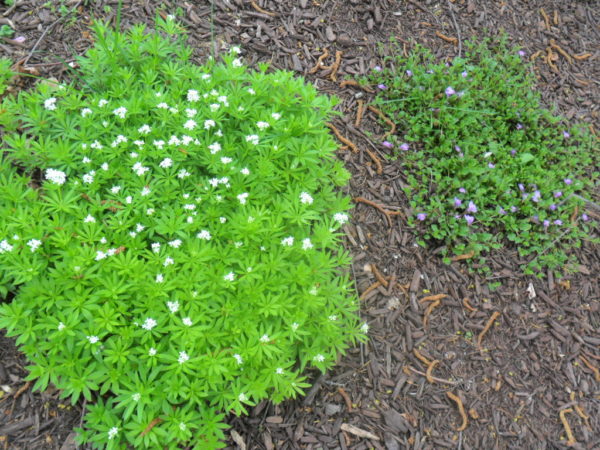
As May begins, perennials begin to gain ground on the bulbs, and two groundcovers are coming into flower: Mazus Reptans and Galium Odoratum. Mazus is a lovely creeper, with dense foliage composed of teeny spoon-shaped, frilled leaves in medium green, which keeps weed growth down quite well. In early to mid-spring, and occasionally afterward, it produces an almost orchid-like flower, two-toned purple with a white, brown-speckled throat. It also tolerates foot traffic, though I am at pains not to trod on it while it’s establishing itself.
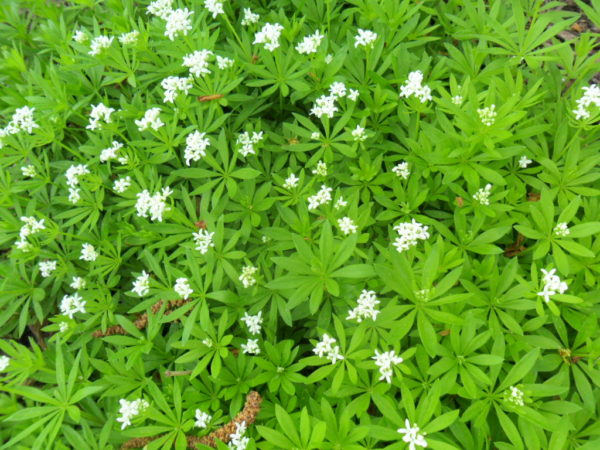
Galium is better known as sweet woodruff, a longtime favorite I have cultivated on all my properties over the years. Whorls of soft green dagger-shaped leaves come in sets of eight, each set protruding at regular intervals from a central stem like so many floors of a high-rise apartment building, though standing no more than 3-4 inches in height total. As May Day comes, each sprig is capped with a cluster of small, pure white, star-shaped flowers, like flecks of foam on a sea-green ocean. Woodruff spreads rapidly, and is also a good weed control; its flowered sprigs were used to season wine for Beltane celebrations in days gone by.
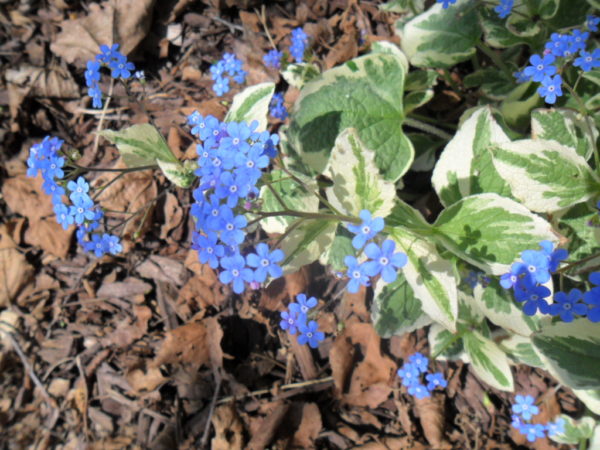
The earliest of my perennials to bloom is Brunera, a glowing green-and-white variegated plant that I acquired late last spring to brighten the shade garden. I’m not sure if I even knew when I bought it, that it bloomed, and I was surprised this spring, both by the earliness of its reemergence and the rapidity of its spread, and then by the profusion of small azure-blue blossoms, five-petaled with open white centers, reminiscent of Forget-me-not. It’s been flowering for weeks now, and still going strong.
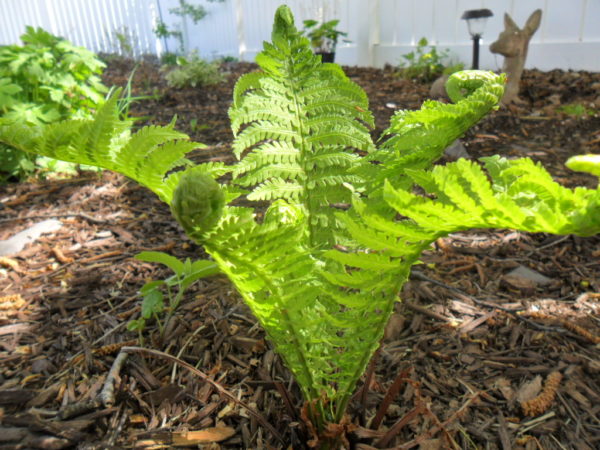
The ferns are up and doing, and spreading nicely. But they’ve got nothing on the vinca, which is disseminating itself like the weed it is. I have two types – deep green and yellow-green variegated, both of which yield a small pale violet flower in spring. Vinca can be invasive, returning not just at its base, but also at random intervals along its long trailing vines, where they make adequate contact with soil. In time this will be an issue, but right now, with so much space to fill, it’s frankly an asset.

Another of what my friend Martha calls “garden thugs” is Archangel, a rapid spreader that will dominate its landscape in no time flat. With variegated green and silver-white foliage, by May Day this mint family member sends up tall spikes dotted with yellow snapdragon-like blossoms. Doing equally well in sun or shade, I have no problem giving over the entire garden to this lush groundcover.
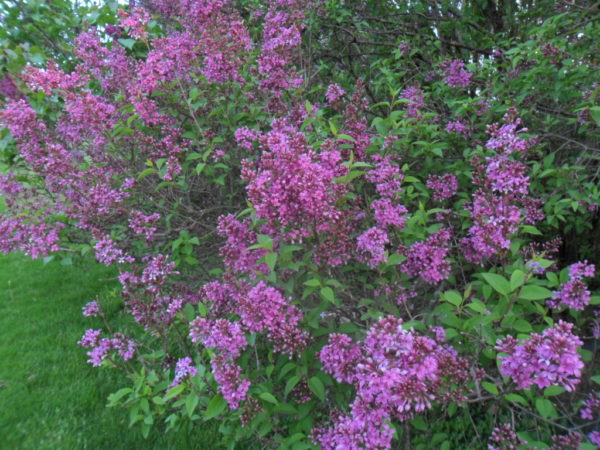
Also coming in now are the lilacs. I inherited a number of these, from an old single white variety to pale purple, white and deep burgundy double lilacs, and a delicate, airy medium-purple French lilac as well. Typically it is only the French lilacs which are in bloom by May Day, with the others opening shortly after, but a burst of heat in late April has accelerated their schedule, and all are in full bloom for Beltane this year.
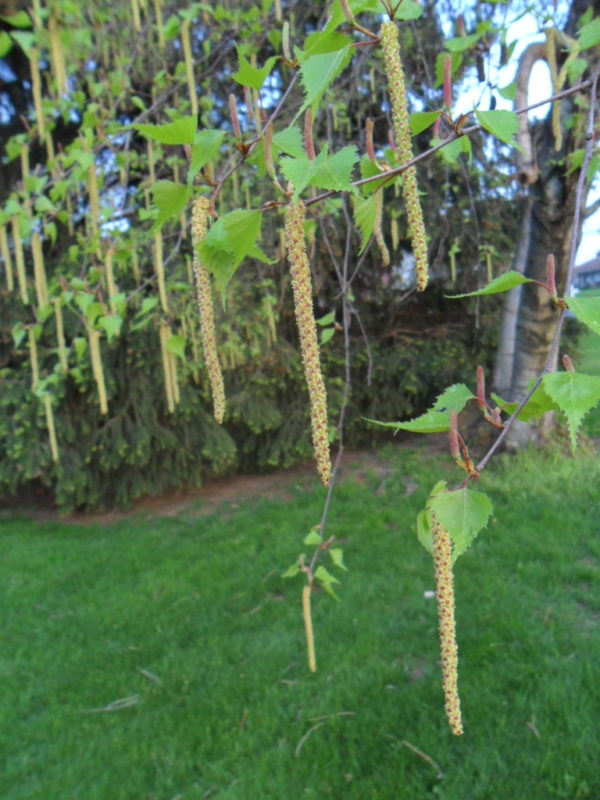
It’s not just bulbs, shrubs and perennials which are in flower now, many trees are spreading pollen with unusual blossoms worthy of attention. I have always enjoyed birch’s dangling, wormlike blooms of yellow-green, making the tree seem alive with annelids. These pollen-heavy catkins will fall in huge numbers, littering the ground as the new leaves emerge, to be replaced with small green fingerlike seed clusters that over the course of the summer will develop into larger versions of themselves, and then mature into browned digits that shatter into thousands of miniscule, disklike, individual seeds in late autumn and winter.
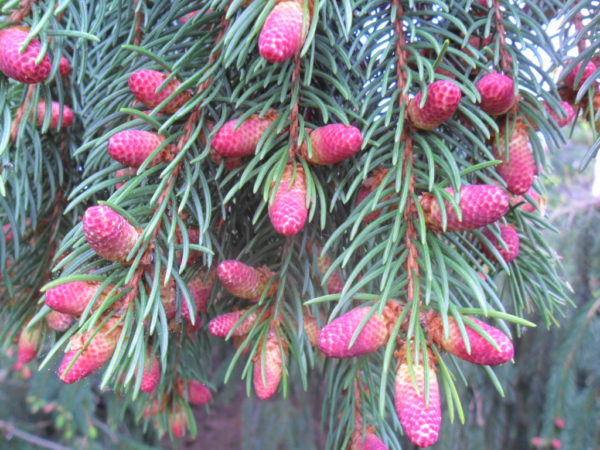
Something new caught my eye this spring, as for the first time ever I noted small purple cones hanging from the pendulous branches of our Norway spruce. I brought this home with me from school in a paper cup in the Sixth Grade, in 1971, on the second celebration of Earth Day. Turning fifty this year, he now towers over the house, and I have long prized the elongated, tightly-packed mature cones it produces, but never noticed its bloom phase before. I stood there gawking with mouth agape at these impossibly purple mini-cones, wondering how I missed them all these years! I’m uncertain if these will each mature into a cone, or like the birch blossoms, fall away at some point to be replaced by fertilized specimens. But the tree is absolutely covered in them, so perhaps a bumper crop of craft supplies is in the making!
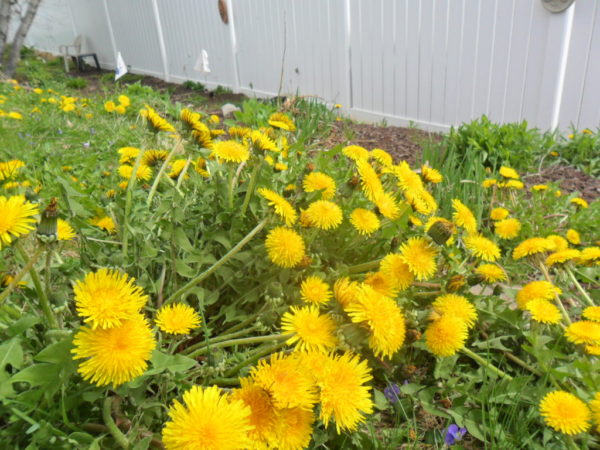
This cultivated garden is all fine, but truthfully, some of the greatest glories of May Day are those we never planted: violets and dandelions. Call me crazy, but I love the look of these sprinkled in the remaining grass paths or clumped in the beds. To my mind, there is nothing sunnier or more cheerful than the bright yellow of a dandelion, and they make a lovely contrast with the deep purple of violets, blooming concurrently. Dandelions are also edible, though I’d have to be feeding the Marines to use all mine in that manner! I also have a few white violets on the property, which I am careful to transplant from paths, where they might be inadvertently trodden into non-existence, to beds and borders, where they can thrive.

Soon to come are more flowering shrubs – Bridal Wreath, Wiegela and Leatherleaf Viburnum -as well as dogwood, crabapple and cherry trees. There’s even another crop of bulbs to bring up the rear of the springtime parade – the Hyacinthoides Hispanica, or “Spanish Bluebells”, also known as wood hyacinths. These will close the show in mid-late May, a full three months after snowdrops and crocus were the opening acts.
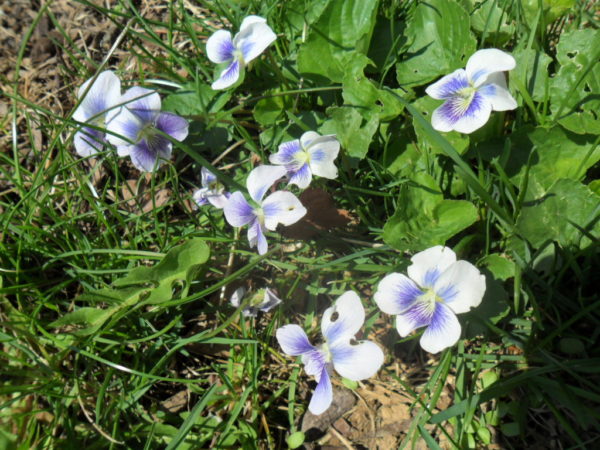
In the meantime, it’s planting season! In addition to the new spring ephemerals mass planting, there’s more summer-blooming perennials trickling in by twos and threes, and a host of seeds to be sown. A gardener’s work is never done!


5 comments, add yours.
Jacqueline
Alex, I have always enjoyed your asteroid blogs for the education and information. But this May Day Garden “walk” through your spring garden was a soul enhancer indeed. I have felt that the flora and fauna have thoroughly enjoyed the warm/cold spring weather we have had this year. The colors seem brighter and more intense. I have had plants appear in my rock garden that I did not plant and am certain that they must have been planted by a previous owner awaiting an epiphany moment. Thank you, once again, Alex, for sharing the beauty and earth creativity you nurture.
Charlotte
A feast of loveliness! Thank you, Alex.
loel
Thank you, Alex! for the beautiful walk thru in the garden of delights! Happy May Day!!
Laurien
I loved all the photos and plant information! Perhaps you have even made me enthusiastic enough to do some gardening of my own! The purple mini pine cones of the Norway spruce are so neat! I hope they dry nicely and can be added to some of your seasonal decorations! Happy Beltane!
Susan Pomeroy
Happy Beltane, Alex! And thanks for sharing the beauties of your garden. I really enjoyed the colorful tour.